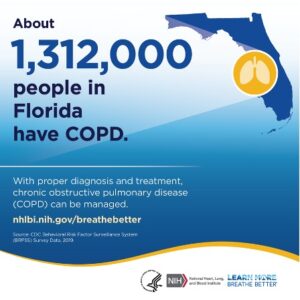
The month of November is COPD Awareness Month, so now is the perfect time to review your risk factors.
Chronic obstructive pulmonary disease (COPD) is the umbrella term for a wide range of progressive lung diseases, including chronic bronchitis, emphysema and irreversible asthma. COPD impacts over 16 million Americans at any given time, many of which are unaware they have one of these conditions.
Some of the most common COPD symptoms include:
- A long-lasting cough, including coughing up mucus
- Shortness of breath
- Tightness in the chest
- Wheezing

Historically, COPD was thought to be a “man’s disease.” However, statistics now show that women are more affected by COPD than men. In 2000, in the U.S., data revealed for the first time that more women died from COPD than men.
Moreover, there are more women living with COPD every day.
Let’s take a look at a few reasons why COPD impacts women more (and differently) than men.
Women and COPD
When women are diagnosed with COPD, it tends to be at a later stage than when men are diagnosed. The later COPD is diagnosed, the less effective the available treatment(s) is on the condition(s). Moreover, a woman’s body has been shown to be more vulnerable to tobacco, as well as other pollutants commonly responsible for COPD.
Another concern with women and COPD is that they generally have other health conditions simultaneously associated with COPD. For example:
- Asthma. Women with COPD also have a greater chance of suffering from asthma.
- Osteoporosis. Some studies have shown that half of women living with COPD also have osteoporosis. While scientists don’t yet know why this is, there is a belief that the steroid medications commonly prescribed for COPD are the culprit. Other studies, however, show that women with COPD just seem to have a higher risk for osteoporosis.
- Anxiety. Women with COPD are at a greater risk of anxiety and depression.
- Inflammation. Scientists believe that COPD can lead to widespread inflammation, which can lead to stiff blood vessels and a buildup of plaque. This buildup can cause heart disease.
Common causes and types of COPD
It’s important to have an awareness month for COPD because many people are unaware of the specifics of the condition.
For instance, many folks don’t know there are actually 3 main causes. While smoking is the main culprit, it doesn’t mean that smoking is the only way you can get COPD. Those who have long-term exposure to certain workplace pollutants (such as toxic chemicals) are also at higher risk. You can also simply be genetically predisposed to developing COPD.
In addition, many people don’t understand that there are different kinds of COPD. Since COPD is an umbrella term for multiple respiratory illnesses, both diagnosing and treating COPD can be difficult. If 2 people in the same household have COPD, there is a real chance that they have different types and that different medications will be used to control the disease(s).
Secondhand smoke can also cause COPD, just as easily as smoking itself. There have been instances where children living with smokers have been diagnosed with COPD. Likewise, vaping e-cigarettes can cause COPD.
How to observe COPD awareness month
If you want to get involved in COPD Awareness Month, visit the NIH website for ways to participate. Here are some quick and easy ways you can get involved:
- Take part in a chat on Twitter or reach out on social media. Do a quick search on Twitter and find a discussion on the ways to manage COPD. You can also link up with the COPD Foundation on Twitter to find local events. You can do the same on Facebook.
- Schedule a doctor’s appointment. If you’re familiar with the symptoms of COPD and you’re experiencing any (such as tightness in the chest or wheezing), then make a commitment to see your doctor. If you do get a COPD diagnosis, the sooner you can begin treatment, the sooner you can start feeling better and begin to reverse some of your lung damage.
- Wear orange. It may not seem like much, but the color of COPD Awareness Month is orange; therefore, you can show solidarity by wearing orange. This effort is similar to people raising awareness for breast cancer by wearing pink. From there, you begin a conversation about COPD.


